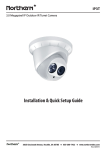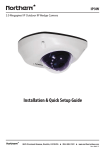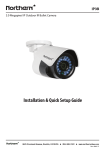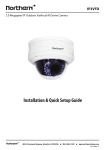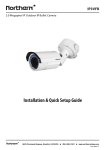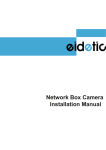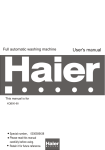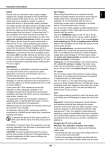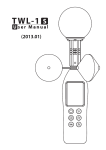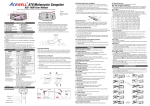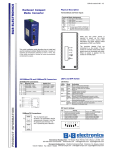Download Untitled - Tri-Ed Distribution
Transcript
Network Installation Bullet Camera· & QuickQuick Setup Operation Guide Guide Thank you for purchasing our product. If there are any questions, or requests, please do not hesitate to contact us. About This Document This manual may contain several technical incorrect places or printing errors, and the content is subject to change without notice. The updates will be added to the new version of this manual. We will readily improve or update the products or procedures described in the manual. DISCLAIMER STATEMENT “Underwriters Laboratories Inc. (“UL”) has not tested the performance or reliability of the security or signaling aspects of this product. UL has only tested for fire, shock or casualty hazards as outlined in UL’s Standard(s) for Safety, UL60950-1. UL Certification does not cover the performance or reliability of the security or signaling aspects of this product. UL MAKES NO REPRESENTATIONS, WARRANTIES OR CERTIFICATIONS WHATSOEVER REGARDING THE PERFORMANCE OR RELIABILITY OF ANY SECURITY OR SIGNALING RELATED FUNCTIONS OF THIS PRODUCT. 1 Installation & Quick SetupOperation Guide Guide Network Turret Camera·Quick Regulatory Information FCC Information FCC compliance: This equipment has been tested and found to comply with the limits for a digital device, pursuant to part 15 of the FCC Rules. These limits are designed to provide reasonable protection against harmful interference when the equipment is operated in a commercial environment. This equipment generates, uses, and can radiate radio frequency energy and, if not installed and used in accordance with the instruction manual, may cause harmful interference to radio communications. Operation of this equipment in a residential area is likely to cause harmful interference in which case the user will be required to correct the interference at his own expense. FCC Conditions This device complies with part 15 of the FCC Rules. Operation is subject to the following two conditions: 1. This device may not cause harmful interference. 2. This device must accept any interference received, including interference that may cause undesired operation. EU Conformity Statement This product and - if applicable - the supplied accessories too are marked with "CE" and comply therefore with the applicable harmonized European standards listed under the Low Voltage Directive 2006/95/EC, the EMC Directive 2004/108/EC, the RoHS Directive 2011/65/EU. 2 1 Installation & Quick SetupOperation Guide Guide Network Turret Camera·Quick 2012/19/EU (WEEE directive): Products marked with this symbol cannot be disposed of as unsorted municipal waste in the European Union. For proper recycling, return this product to your local supplier upon the purchase of equivalent new equipment, or dispose of it at designated collection points. For more information see: www.recyclethis.info. 2006/66/EC (battery directive): This product contains a battery that cannot be disposed of as unsorted municipal waste in the European Union. See the product documentation for specific battery information. The battery is marked with this symbol, which may include lettering to indicate cadmium (Cd), lead (Pb), or mercury (Hg). For proper recycling, return the battery to your supplier or to a designated collection point. For more information see: www.recyclethis.info 3 & Quick Setup Guide Guide NetworkInstallation Turret Camera·Quick Operation Safety Instruction These instructions are intended to ensure that user can use the product correctly to avoid danger or property loss. The precaution measure is divided into “Warnings” and “Cautions” Warnings: Serious injury or death may occur if any of the warnings are neglected. Cautions: Injury or equipment damage may occur if any of the cautions are neglected. Warnings Follow these safeguards to prevent serious injury or death. Cautions Follow these precautions to prevent potential injury or material damage. Warnings ● In the use of the product, you must be in strict compliance with the electrical safety regulations of the nation and region. Please refer to technical specifications for detailed information. ● Input voltage should meet both the SELV (Safety Extra Low Voltage) and the Limited Power Source with 24 VAC or 12 VDC according to the IEC60950-1 standard. Please refer to technical specifications for detailed information. 4 3 NetworkInstallation Bullet Camera·Quick & Quick Setup Operation Guide Guide • • • Do not connect several devices to one power adapter as adapter overload may cause over-heating or a fire hazard. Please make sure that the plug is firmly connected to the power socket. When the product is mounted on wall or ceiling, the device shall be firmly fixed. If smoke, odor or noise rise from the device, turn off the power at once and unplug the power cable, and then please contact a qualified service technician. Cautions • • • • • Make sure the power supply voltage is correct before using the camera. Do not drop the camera or subject it to physical shock. Do not touch sensor modules with fingers. If cleaning is necessary, use clean cloth with a bit of ethanol and wipe it gently. If the camera will not be used for an extended period, please replace the lens cap to protect the sensor from dirt. Do not aim the camera at the sun or extra bright places. Blooming or smearing may occur otherwise (which is not a malfunction), and affect the endurance of sensor at the same time. The sensor may be burned out by a laser beam, so when any laser equipment is in use, make sure that the surface of sensor will not be exposed to the laser beam. 5 NetworkInstallation Bullet Camera·Quick & Quick Setup Operation Guide Guide • • • • • • Do not install the camera in areas outside of the normal operating range of -30°C ~ +60°C and do not expose it to high electromagnetic radiation. To avoid heat accumulation, good ventilation is required for operating environment. Do not expose internal camera components to liquid or moisture. When transporting the camera it should remain in its original packaging to avoid damage. Improper use or replacement of the battery may result in hazard of explosion. Replace with the same or equivalent type only. Dispose of used batteries according to the instructions provided by the battery manufacturer. If the product does not work properly, please contact your dealer or the nearest service center. Never attempt to disassemble the camera yourself. (We shall not assume any responsibility for problems caused by unauthorized repair or maintenance.) 6 5 & Quick Setup Guide Guide NetworkInstallation Turret Camera·Quick Operation Table of Contents 1 Appearance Description ................................................................. 8 2 Installation .................................................................................... 10 3 Setting the Network Camera over the LAN .................................. 16 4 Accessing via Web Browser .......................................................... 21 7 Installation & Quick Setup Guide 1 Appearance Description Figure 1-1 Overview Table 1-1 Description NO. Description 1 10M/100M self-adaptive Ethernet interface 2 Power Cable 3 Trim Ring 8 7 Installation & Quick Setup Guide NO. Description 4 Lens 5 IR LED 6 Enclosure 7 Dome Drive 8 Reset Please make sure that the power adapter is compatible with the camera. This series of camera supports Power over Ethernet (PoE), and the standard power supply is 12 VDC. 9 NetworkInstallation Turret Camera·Quick & Quick Setup Opera Guideon Guide 2 Installation Before you start: • Make sure the device in the package is in good condi on and all the assembly parts are included. • Make sure all the related equipment is powered off during the installa on. • Check the specifica on of the products for the installa on environment. • Make sure the power supply matches with your required voltage to avoid damage. • If the product does not func on properly, please contact your dealer or the nearest service center. Do not disassemble the camera for repair or maintenance by yourself. • Make sure that the wall is strong enough to withstand three mes the weight of the camera. For cameras with IR, you are required to pay a en on to the following precau ons to prevent IR reflec on: • Dust or grease on the Lens cover will cause IR reflection. Please do not remove the Lens cover film un l the installa on is finished. If there is dust or grease on the Lens cover, clean the Lens cover with clean so cloth and isopropyl alcohol. 10 • NetworkInstallation Turret Camera·Quick & Quick Setup Operation Guide Guide Make sure that there are no reflective surfaces too close to the camera lens. The IR light from the camera may reflect back into the lens causing reflection. Steps: 1. Rotate the trim ring counterclockwise to remove it from the camera. Trim Ring Dome Drive Figure 2-1 Dissemble the Camera 11 & Quick Setup Guide Guide NetworkInstallation Turret Camera·Quick Operation 2. Drill the screw holes and the cable hole on the ceiling according to the drill template. Figure 2-2 The Drill Template There are two cable outlet methods. One is to route the cables through the cable hole, and the other is to route the cables through the side outlet shown below. Figure 2-3 Side Outlet 12 1 & Quick Setup Guide Guide NetworkInstallation Turret Camera·Quick Operation Three side outlets on the enclosure are selectable, which makes routing the cables easier instead of drilling a cable hole on the ceiling. Use a plier to remove the plastic and route the cables through the hole. 3. 4. Connect the corresponding power/network cable. Fix the camera to the ceiling with the supplied expansion screws. Figure 2-4 Secure the Camera to the Ceiling 5. Adjust the Lens. 1). Loosen the lock screw. 2). Rotate the enclosure to adjust the pan angle; rotate the camera to adjust the tilt angle. 13 & Quick Setup Guide Guide NetworkInstallation Turret Camera·Quick Operation 3). Tighten the lock screw to fix the optimum surveillance angle. Lock Screw Figure 2-5 Lock Screw Figure 2-6 Adjust the Lens 14 1 & Quick Setup Guide Guide NetworkInstallation Turret Camera·Quick Operation 6. Attach the trim ring to the camera and rotate the trim ring clockwise to get it secured. Figure 2-7 Install the Trim Ring Figure 2-8 Complete the Installation 15 Network Dome Camera·Quick Start Guide 3 Setting up Network Cameras over a LAN Note: You shall acknowledge that the use of the product with Internet access might be under network security risks. For avoidance of any network attacks and information leakage, please strengthen your own protection. If the product does not work properly, please contact with your dealer or the nearest service center. 3.1 Wiring Please connect to the camera to the network according to the following figures Figure 3-1 Connecting Directly Figure 3-2 Connecting via a Switch or a Router 16 Network Dome Camera·Quick Start Guide 3.2 Activating the Camera You are required to activate the camera first by setting a strong password for it before you can use the camera. Activation via Web Browser, Activation via SADP, and Activation via Client Software are all supported. We take activation via SADP software and Activation via Web Browser as examples to introduce the camera activation. Please refer to the User Manual of Network Camera for Activation via Client Software. 3.2.1 Activation via Web Browser Steps: 1. Power on the camera, and connect the camera to the network. 2. Input the IP address into the address bar of the web browser, and click Enter to enter the activation interface. Notes: The default IP address of the camera is 192.168.1.64. Figure 3-3 Activation Interface(Web) 17 Network Dome Camera·Quick Start Guide 3. Create a password and input the password into the password field. STRONG PASSWORD RECOMMENDED– We highly recommend you create a strong password of your own choosing (using a minimum of 8 characters, including upper case letters, lower case letters, numbers, and special characters) in order to increase the security of your product. And we recommend you reset your password regularly, especially in the high security system, resetting the password monthly or weekly can better protect your product. 4. Confirm the password. 5. Click OK to save the password and enter the live view interface. 3.2.2 Activation via SADP Software SADP software is used for detecting the online device, activating the camera, and resetting the password. Get the SADP software from the supplied disk or the official website, and install the SADP according to the prompts. Follow the steps to activate the camera, please refer to the User Manual of Network Camera for other two activation methods. Steps: 1. Run the SADP software to search the online devices. 2. Check the device status from the device list, and select the inactive device. 18 Network Dome Camera·Quick Start Guide Figure 3-4 SADP Interface Note: The SADP software supports activating the camera in batch. Please refer to the User Manual of SADP software for details. 3. Create a password and input the password in the password field, and confirm the password. 19 Network Dome Camera·Quick Start Guide STRONG PASSWORD RECOMMENDED– We highly recommend you create a strong password of your own choosing (using a minimum of 8 characters, including upper case letters, lower case letters, numbers, and special characters) in order to increase the security of your product. And we recommend you reset your password regularly, especially in the high security system, resetting the password monthly or weekly can better protect your product. 4. Click OK to save the password. You can check whether the activation is completed on the popup window. If activation failed, please make sure that the password meets the requirement and try again. 3.3 Modifying the IP Address Purpose: To view and configure the camera via LAN (Local Area Network), you need to connect the network camera in the same subnet with your PC. Then, install the SADP software or client software to search and change the IP of network camera. We will take modifying the IP Address via SADP software as an example to introduce the IP address modification. Steps: 1. Run the SADP software. 2. Select an activate device. 20 Network Dome Camera·Quick Start Guide Note: Please refer to Chapter 3.2 to activate the camera if the camera is inactive. 3. Change the device IP address to the same subnet with your computer by either modifying the IP address manually or checking the checkbox of Enable DHCP. Figure 3-5 Modify the IP Address 4. Input the password to activate your IP address modification. The batch IP address modification is supported by the SADP. Please refer to the User Manual of SADP for details. 21 Network Dome Camera·Quick Start Guide 4 Accessing via Web Browser System Requirement: Operating System: Microsoft Windows XP SP1 and above version CPU: 2.0 GHz or higher RAM: 1G or higher Display: 1024×768 resolution or higher Web Browser: Internet Explorer 8.0 and above version, Apple Safari 5.0.2 and above version, Mozilla Firefox 5.0 and above version and Google Chrome 18 and above version Steps: 1. Open the web browser. 2. In the browser address bar, input the IP address of the network camera, and press the Enter key to enter the login interface. Note: The default IP address is 192.168.1.64. If the camera is not activated, please activate the camera first according to Chapter 3.2. 3. Input the user name and password. The admin user should configure the device accounts and user/operator permissions properly. Delete the unnecessary accounts and user/operator permissions. Note: The device IP address gets locked if the admin user performs 7 failed password attempts (5 attempts for the user/operator). 22 Network Dome Camera·Quick Start Guide 4. Click Login. Figure 4-1 Login Interface 5. Install the plug-in before viewing the live video and managing the camera. Please follow the installation prompts to install the plug-in. You may have to close the web browser to finish the installation of the plug-in. 23 Network Dome Camera·Quick Start Guide Figure 4-2 Download Plug-in Figure 4-3 Install Plug-in (1) 24 Network Dome Camera·Quick Start Guide Figure 4-4 Install Plug-in (2) 6. Reopen the web browser after the installation of the plug-in and repeat steps 2~4 to login. For detailed instructions of further configuration, please refer to the user manual of network camera. 25



























